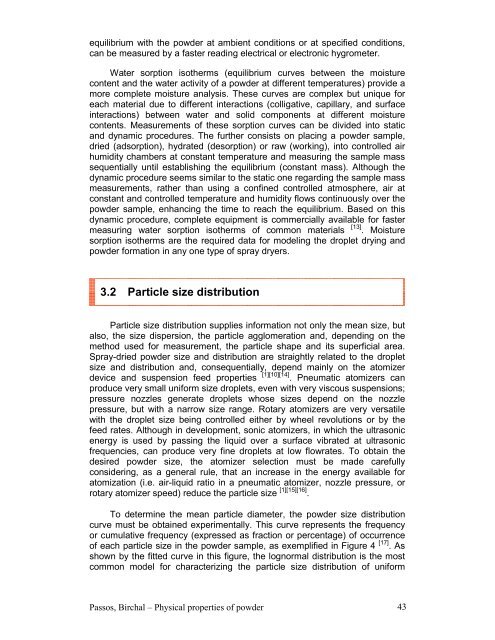Spray Drying Technology.pdf - National University of Singapore
Spray Drying Technology.pdf - National University of Singapore
Spray Drying Technology.pdf - National University of Singapore
Create successful ePaper yourself
Turn your PDF publications into a flip-book with our unique Google optimized e-Paper software.
equilibrium with the powder at ambient conditions or at specified conditions,<br />
can be measured by a faster reading electrical or electronic hygrometer.<br />
Water sorption isotherms (equilibrium curves between the moisture<br />
content and the water activity <strong>of</strong> a powder at different temperatures) provide a<br />
more complete moisture analysis. These curves are complex but unique for<br />
each material due to different interactions (colligative, capillary, and surface<br />
interactions) between water and solid components at different moisture<br />
contents. Measurements <strong>of</strong> these sorption curves can be divided into static<br />
and dynamic procedures. The further consists on placing a powder sample,<br />
dried (adsorption), hydrated (desorption) or raw (working), into controlled air<br />
humidity chambers at constant temperature and measuring the sample mass<br />
sequentially until establishing the equilibrium (constant mass). Although the<br />
dynamic procedure seems similar to the static one regarding the sample mass<br />
measurements, rather than using a confined controlled atmosphere, air at<br />
constant and controlled temperature and humidity flows continuously over the<br />
powder sample, enhancing the time to reach the equilibrium. Based on this<br />
dynamic procedure, complete equipment is commercially available for faster<br />
measuring water sorption isotherms <strong>of</strong> common materials [13] . Moisture<br />
sorption isotherms are the required data for modeling the droplet drying and<br />
powder formation in any one type <strong>of</strong> spray dryers.<br />
3.2 Particle size distribution<br />
Particle size distribution supplies information not only the mean size, but<br />
also, the size dispersion, the particle agglomeration and, depending on the<br />
method used for measurement, the particle shape and its superficial area.<br />
<strong>Spray</strong>-dried powder size and distribution are straightly related to the droplet<br />
size and distribution and, consequentially, depend mainly on the atomizer<br />
device and suspension feed properties [1][10][14] . Pneumatic atomizers can<br />
produce very small uniform size droplets, even with very viscous suspensions;<br />
pressure nozzles generate droplets whose sizes depend on the nozzle<br />
pressure, but with a narrow size range. Rotary atomizers are very versatile<br />
with the droplet size being controlled either by wheel revolutions or by the<br />
feed rates. Although in development, sonic atomizers, in which the ultrasonic<br />
energy is used by passing the liquid over a surface vibrated at ultrasonic<br />
frequencies, can produce very fine droplets at low flowrates. To obtain the<br />
desired powder size, the atomizer selection must be made carefully<br />
considering, as a general rule, that an increase in the energy available for<br />
atomization (i.e. air-liquid ratio in a pneumatic atomizer, nozzle pressure, or<br />
rotary atomizer speed) reduce the particle size [1][15][16] .<br />
To determine the mean particle diameter, the powder size distribution<br />
curve must be obtained experimentally. This curve represents the frequency<br />
or cumulative frequency (expressed as fraction or percentage) <strong>of</strong> occurrence<br />
<strong>of</strong> each particle size in the powder sample, as exemplified in Figure 4 [17] . As<br />
shown by the fitted curve in this figure, the lognormal distribution is the most<br />
common model for characterizing the particle size distribution <strong>of</strong> uniform<br />
Passos, Birchal – Physical properties <strong>of</strong> powder 43

















